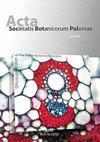The Phylogenetic Position of Vincetoxicum pannonicum (Borhidi) Holub Supports the Species' Allopolyploid Hybrid Origin
IF 0.8
4区 生物学
Q3 PLANT SCIENCES
引用次数: 2
Abstract
The Pannonian endemic species Vincetoxicum pannonicum was described from specimens collected in Hungary and occurs at only few locations. It is considered “vulnerable” according to the International Red List. The chromosome set was reported to be tetraploid, and the species was hypothesized to be an allotetraploid hybrid of the Balkan species V. fuscatum and the Adriatic species V. hirundinaria subsp. adriaticum. We investigated the origin of V. pannonicum using molecular phylogenetic methods by separately analyzing the multicopy nuclear ribosomal internal transcribed spacer (nrITS) and the plastid-encoded trnH-psbA DNA regions and by evaluating discrepancies between the produced gene trees. Paralogs in the nrITS region clustered in two main groups, one of which was closest to V. fuscatum, and the other included V. hirundinaria subsp. adriaticum. According to trnH-psbA sequences, V. pannonicum and V. hirundinaria subsp. adriaticum formed a single group. Our results show that V. pannonicum diversified because of hybrid speciation, in which V. fuscatum was the pollen donor. We discovered a similar placement of V. maeoticum, which suggests a further hybridization event between V. fuscatum and a species of the V. hirundinaria group. Our genome-size estimate indicates almost sixfold larger genome size in V. pannonicum compared to the maternal diploid parent, suggesting hexaploidy; however, V. pannonicum is tetraploid. This may suggest cytological diploidization in the allopolyploid V. pannonicum. We observed substantial genetic distance between V. hirundinaria subsp. adriaticum and all other subspecies of V. hirundinaria, and we therefore propose that V. adriaticum should be regarded as a separate species.长春花(Vincetoxicum pannonicum (Borhidi) Holub)的系统发育位置支持该物种的异源多倍体杂交起源
潘诺尼亚特有种潘诺尼乌姆(Vincetoxicum pannonicum)是从匈牙利收集的标本中描述的,仅在少数地点发生。根据国际红色名录,它被认为是“脆弱的”。据报道,该物种的染色体组为四倍体,并且该物种被假设为巴尔干种V. fuscatum和亚得里亚海种V. hirundinaria亚种的异源四倍体杂种。adriaticum。通过对多拷贝核糖体内转录间隔区(nrITS)和质体编码的trnH-psbA DNA区域的分离分析,以及所产生的基因树之间的差异,采用分子系统发育方法研究了pannonicum的起源。nrITS地区的类群聚集在两个主要类群中,其中一个类群最接近fuscatum,另一个类群包括hirundinaria亚类群。adriaticum。根据trn - h - psba序列,pannonicum和hirundinaria亚种。亚得里亚海形成了一个单一的群体。结果表明,pannonicum因杂交形成而多样化,其中fuscatum为花粉供体。我们发现了一个类似的位置,这表明fuscatum和V. hirundinaria组的一个物种之间有进一步的杂交事件。我们的基因组大小估计表明,与母本二倍体相比,pannonicum的基因组大小几乎是母本的六倍,可能是六倍体;然而,V. pannonicum是四倍体。这可能表明异源多倍体V. pannonicum发生了细胞学二倍体化。结果表明,水蛭亚种与水蛭亚种之间存在较大的遗传距离。因此,我们建议将adriaticum作为一个单独的种来看待。
本文章由计算机程序翻译,如有差异,请以英文原文为准。
求助全文
约1分钟内获得全文
求助全文
来源期刊
CiteScore
2.00
自引率
10.00%
发文量
18
审稿时长
1 months
期刊介绍:
The journal has been published since 1923 and offers Open Access publication of original research papers, short communications, and reviews in all areas of plant science, including evolution, ecology, genetics, plant structure and development, physiology and biochemistry.

 求助内容:
求助内容: 应助结果提醒方式:
应助结果提醒方式:


